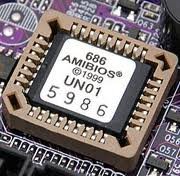Actually, flashing a BIOS is not hard. Not hard at all. In fact, it's SO EASY to SCREW UP the motherboard by flashing the BIOS. 😁
From what I know :
1. ROM chips are formatted with varying sizes - 128K, 256K, 512k, etc. and some with different block assignments.
2. Use Uniflash (file attached below) for flashing - more versatile, very "hot-flashing" friendly. (It's the only one I use irrespective of motherboard types and bios.)
Although Uniflash is versatile, it is also intelligent enough to prevent any "blind" flashing - meaning roms of different size being installed in a different sized rom chip configuration.
(But it still doesn't check if the bios being flashed is compatible with the motherboard on which it is being flashed.)
Recently, I got a rare board (at least that's what I think) - a DFI LanParty 875PT chipset board.
I think it's rare since it uses intel's i875 chipset and at the same time, uses AGP8X slot, not PCI-E. Just right for my Geforce 6800 Ultra AGP8X.
Problem was, it arrived DOA despite the seller's claim at ebay, as "100% Fully Working" board!!
This board uses the newer PLCC Bios - which is almost square in shape, and are present in newer boards.

I used Uniflash to check the bios - I booted up another board using the same PLCC bios slot (Another DFI based Socket 7 board). I removed it's bios and installed the 875PT's bios while the former board was still running and using Uniflash's refresh feature (re-detect BIOS ROM)... and good enough - it showed that the BIOS chip is bad - Uniflash unable to read the BIOS information from this chip.
I then got another chip from an old AMD board, which is using the same PLCC type bios chip, hot-flashed the 875PT motherboard using the bios downloaded from DFI website, and the board came alive. 😀

